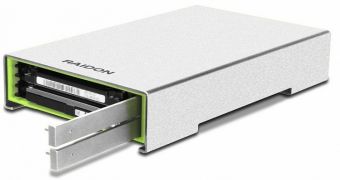There are plenty of USB-connected hard disk drives and solid state drives in this world, but sometimes just one isn't enough, or maybe you want larger capacity but also some security. That's where RAID enclosures like the RAIDON GR2660-B3 come into play.
RAID, which is short for redundant array of independent disks, is a virtualization technology that combines multiple HDD or SSD components into a logical unit with higher performance and/or security.
There are several modes you can settle for, depending on which you favor more between the two (performance and security that is).
RAID 0 uses a technique called striping to ensure a significant performance rise but at the cost of no data redundancy or fault tolerance (if one disk dies, all the data is lost even if it's stored on the other one).
RAID 1 uses mirroring to have two instances of the data at all times, meaning that the write performance is determined by the slowest drive in the array, but the death of one disk ensures you lose nothing.
RAID 2 is no longer used, because its technology (disk synching and splitting of each sequential bit on a different disk) only works on HDDs and was found insufficient compared to the others, both performance- and security-wise. RAID 3 is similar, but splits data by bytes. It's used sometimes, but rarely. RAID 4 is even more rarely used (block-level striping with dedicated parity).
Thus, besides RAID 0 and 1, only RAID 5 and 6 are of any note. The former can ensure no data is lost in case one drive fails, but if a second one dies before the initial one is replaced, everything is scrapped. RAID 6 can handle two failed drives.
The new RAID enclosure from RAIDON, the GR2660-B3, can arrange 2.5-inch HDDs or SSDs in RAID 1 (safe mode) or RAID 0 (speed mode). It can also set them up in a non-RAID architecture called JBOD (just a bunch of disks), which doesn't provide performance/security benefits but allows independent drive management.
It's a good thing that the GR2660-B3 is more likely to be equipped with SSDs than HDDs, because they essentially guarantee high performance no matter the setup.
The HDDs/SSDs need to possess SATA III/II connectors, but the case itself connects to a PC via USB 3.0. Unfortunately, RAIDON neglected to provide a price for the GR2660-B3 in its press release. It will probably be of around $60 / €60.

 14 DAY TRIAL //
14 DAY TRIAL //